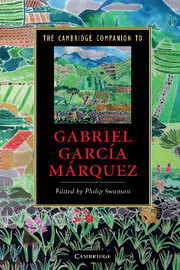Book contents
- Frontmatter
- Introduction
- 1 Gabriel García Márquez: life and times
- 2 The critical reception of García Márquez
- 3 Before One Hundred Years of Solitude: the early novels
- 4 One Hundred Years of Solitude
- 5 An eco-critical reading of One Hundred Years of Solitude
- 6 The Autumn of the Patriarch
- 7 The General in His Labyrinth
- 8 García Márquez’s novels of love
- 9 García Márquez’s short stories
- 10 García Márquez’s non-fiction works
- 11 García Márquez and film
- 12 García Márquez, magical realism and world literature
- Further reading
- Index
11 - García Márquez and film
Published online by Cambridge University Press: 28 September 2010
- Frontmatter
- Introduction
- 1 Gabriel García Márquez: life and times
- 2 The critical reception of García Márquez
- 3 Before One Hundred Years of Solitude: the early novels
- 4 One Hundred Years of Solitude
- 5 An eco-critical reading of One Hundred Years of Solitude
- 6 The Autumn of the Patriarch
- 7 The General in His Labyrinth
- 8 García Márquez’s novels of love
- 9 García Márquez’s short stories
- 10 García Márquez’s non-fiction works
- 11 García Márquez and film
- 12 García Márquez, magical realism and world literature
- Further reading
- Index
Summary
“[My relationship with cinema] is like that of a poorly-matched married couple. That is to say, I can't live with cinema, and I can't live without it. And, to judge by the number of offers that I get from producers, cinema feels the same way about me.” / García Márquez's provocative statement regarding his relationship to cinema provides a sound starting point for the consideration of this Colombian writer and his filmic endeavours. Certainly, the number of Garciamarquian film projects is large and still growing, as attested to by British director Mike Newell's filming of El amor en los tiempos del cólera (Love in the Time of Cholera) (released in the Americas in 2007), Mexican director Carlos Carrera's filming of Noticia de un secuestro (News of a Kidnapping) and Costa Rican Hilda Hidalgo's 2009 film of Del amor y otros demonios (Of Love and Other Demons). The frequency of García Márquez's film-related projects, and those of others to bring his work to the big screen, is thus clear, but these, for a variety of reasons as will be discussed below, have not always lived up to their potential. Whilst García Márquez is undoubtedly best known as the Nobel Prizewinning novelist, his contribution to, and adaptations within, the cinematic realm cannot be underestimated. His relationship with cinema has been prolonged and complex, and he has played a variety of roles, ranging from film critic, scriptwriter, director, member of a variety of film-related organisations and, of course, inspiration for the large number of cinematic adaptations based on his narrative output. We can thus consider his contribution to cinema in terms of three broad areas: García Márquez on cinema, García Márquez as cinema and García Márquez in cinema.
- Type
- Chapter
- Information
- The Cambridge Companion to Gabriel García Márquez , pp. 160 - 178Publisher: Cambridge University PressPrint publication year: 2010
- 1
- Cited by

